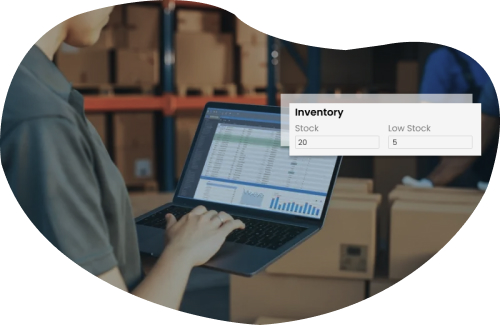Imagine a distributor who continually finds himself in bad situations, such as having out-of-stock of leading products or loads of unpopular products in boxes. No matter how hard they work to increase their contacts, they are losing business behind the scenes. Conversely, a distributor who possesses the precise quantity of products that customers want will be able to fulfill the orders with ease, except for the remaining products, and earn the trust of their team and buyers. Individuals tend to think that inventory management is a pretty boring field, but in fact, it is one of the most successful solutions you can find.
For example, knowing that a certain product is favored during winter or in the Asian market makes you wiser to stock them and reduce losses. More so, you are making informed decisions on account of precise patterns. Strategic inventory management makes all the difference between working hard to sell quickly and consistent business growth.
The mathematics behind inventory management
Normally, network marketers are told to buy bulk inventories of the product as a means of being ready in case of increased demand. Such a method fails to consider multiple economic values, which characterize operations of contemporary supply chain management. Opportunity cost and the cost of having to maintain physical inventory as capital also adds additional cost, besides the invoice price of inventory.
Successful MLM entrepreneurs always recognize that stocks are not mere commodities lying around to be sold, but they are an energetic instrument of finance. That's the same reason why they must be strategically distributed. Every dollar you invested here might have been employed otherwise in cultivating the team, advertising, or for whatever worthy personal development product.
The operation of demand forecasting
The traditional inventory control approaches in multi-level marketing were dependent on historical sales data information. There’s no doubt that such data history provides worthwhile information. Nonetheless, contemporary MLM leaders find it worth considering the incorporation of several variables in their forecasting models.
For example, understanding that a product is sold more during a specific quarter of the year is not sufficient to determine its seasonality. It also involves determining different types of products, some geographies, and micro-seasons. For example, nutritional supplements are not homogeneous in demand; rather, they have different demands depending on micro-seasons of the quarter.
Thus, social listening has also emerged as yet another precise means of forecasting. If you monitor the social media platforms' engagement metrics of your downline constantly, it could be possible that you are aware of the current interest in particular products (weeks prior to when such a pattern would be observed in the sales figures). This type of performance helps in performing preventive stock control rather than crisis control.
The real psychology of inventory
Most of the time, the connection between MLM businesspeople and their stock can become overly emotional, resulting in blurred reasoning and leading to incorrect decisions. Many of the distributors feel more confidence when they have vast inventories and therefore wind up placing excessive orders. Some are even able to develop feelings of affinity for specific products, which they keep ordering in bulk even if they are not selling.
This is the reason that the majority of effective leaders propose "inventory detachment discipline", where their emotional fulfillment is detached from their buying decisions for the inventory. This kind of transformation entails the realization that one is not a wealthy individual who collects things but rather a steward of limited resources to produce more enduring sales.
The velocity-based inventory model
Although there are conventional methods of maintaining optimum levels for raw materials/kits, there are advanced MLM companies that use the velocity inventory model. The model determines various stocking points for all products under a Store Code based on rate of sales, gross margin, size and strategic utilization of the product within a Store Code.
High-margin, high velocity items require higher quantities of safety stock and auto-replenishment points, while low velocity, specialty products may use just-in-time inventory replenishment, and these are supplemented with rapid delivery by the supplier.
The most sophisticated MLM inventory managers divide their products into strategic segments.
The velocity-based inventory model
- Relationship builders: Keep inventory for products that leave a lasting impression, even if they sell slowly.
- Recruitment catalysts: High-velocity products that attract new distributors should be well-stocked.
- Product velocity maintenance: Track top-selling, high-margin products closely to ensure smooth flow and healthy profits.
- Seasonal products: Forecast demand and pre-stock seasonal items before the rush hits.
Relationship builders
Certain products may be seasonal and less frequently used than other goods. But if they make lasting customer impressions and, they should be inventoried despite low rates of turnover.
Recruitment catalysts
Those products that trigger increased distributor interest and enrollment conversation should be inventoried in much larger quantities than others, even though they have high velocity.
Product velocity maintenance
For products that have good margins and are the lifeblood of the business, velocity needs to be monitored very closely while inventory should be optimized.
Seasonal products
Certain products sell more during a particular season of the year, thereby needing strategic methods of forecasting and pre-positioning ahead of the season.
Inventory infrastructure beyond physical storage
MLM inventory management always comes with issues such as the storage of products and where they should be located. While these are critical factors, there is more to proper stock management than the structures mentioned above.
Distributed inventory network is a successful innovation on the current trends list for companies. Similar to stock centralization within a specific zone, this facility establishes a miniature stock center within the downline. It tends to minimize delivery time, lessen transportation expenses, and offer leadership training, by assigning the responsibility of the inventory to some employees.
Partnerships with such distributors in different geographical locations allow one to subscribe to mutual fulfillment agreements. This can actually expand the inventory capacity without necessarily requiring one to buy new inventory assets. Such agreements allow each of the partners to maintain their safety stock level, while clients' needs are satisfied at all times.
Modern MLM software solutions that are designed for end-to-end management of MLM companies give real-time visibility of the key products of an MLM company. The expert systems utilize the sales history, supplier lead time, and other factors to come up with dynamic re-order quantities instead of re-order points.
Inventory as a leadership development tool
Today, inventory management systems also make excellent organizational training grounds for the most important distributors in the team. Through addressing all the essential areas of inventory management such as demand forecasting and supplier negotiations, they are able to develop the appropriate organizational skills while keeping high-value tasks in focus.
It is in reference to this that the inventory apprenticeship program has been created. It is a wonderful example of a formal way of this opportunity for development. The top talent receives the incremental promotion of inventory duties from mere stock checking to managing the stock control system. It also builds confidence in an incremental manner while providing the required operational redundancies to safeguard the business.
The future of MLM inventory management
With the transformation of consumers and technology, the practice of stock management in the field of direct selling should also change. In fact, forward-thinking MLM managers are already applying the ongoing improvements that will become standard practices in the future.
Predictive analysis assists companies by using artificial intelligence to perform their activities. With this, your company will be in a position to forecast subtle trends in your revenue numbers, a firm's behavior on the social media sites, and important financial metrics. These models build a more precise demand forecast that minimizes a firm's risk of stockouts and overstocking.
VMI arrangements like stock holding, empower the vendor to assume complete responsibility of stocks, ownership, stock control and replenishment of goods. It implies that companies can release significant capital without jeopardizing the availability of their stocks. All these alliances are established on mutual trust among partners and sharing of information.
These scheduled programs also make it so that demand is predictable in nature, therefore making inventory manageable while the business accumulates steady revenues from subscriptions. In effect, these programs force customers to make more regular deliveries of products and turn inventory into allocation.
Integrated MLM software: The command center for inventory excellence
Modern software platforms have facilitated higher inventory management. Such programs not only turn into an efficient means of operating business but also turn inventories into assets. Here's why and how:
Automated management: Not just downline tracking, an advanced MLM software offers client-based management tools too. They implement real-time knowledge of sales and make automatic judgments regarding the needed inventory.
Multiple alternate presence: Distributors can view and access inventories from various branches in the chain so that they can respond to local high demand instantly.
Inventory control: Luxury facilities feature the capability to forecast the products a consumer or business will need before the requirement is experienced. This prevents potential overstocking or stockouts that are harmful to the company image.
Integration with commission: The product has been integrated with compensation management functionalities, thus making it simple to calculate commission on the basis of movement of inventory, without having to wait for sales to be executed.
Enhanced co-ordination and supervision: Through the use of strong enterprise solutions, it is simple to control inventory processes while strengthening central command, thus making inventory a strong weapon.
Discover how we build resilient businesses with advanced MLM functionalities
Key takeaways
Even the most seasoned marketers value the fact that inventory management is a competitive weapon and not a logistics function, which has an impact on all the other functions of a firm. Through considering the inventory decisions at the analytical level, acknowledging the psychological bases of decision-making, and possessing strategic vision for inventory decisions, a manager transforms an old-fashioned cost center into a competitive weapon.
These sophisticated concepts of inventory management will give you numerous advantages: improved cash flow, customer service increase, saving of time or decreasing administrative work along with improved confidence by distributors. Certainly, strategic inventory management creates a firm foundation for operation, which addresses things that matter the most, such as your team's development and business expansion.
- Introduction
- The mathematics behind inventory management
- The operation of demand forecasting
- The real psychology of inventory
- The velocity-based inventory model
- The inventory infrastructure
- Inventory as a leadership development tool
- The future of MLM inventory management
- Integrated MLM software benefits
- Key takeaways









Leave your comment
Fill up and remark your valuable comment.